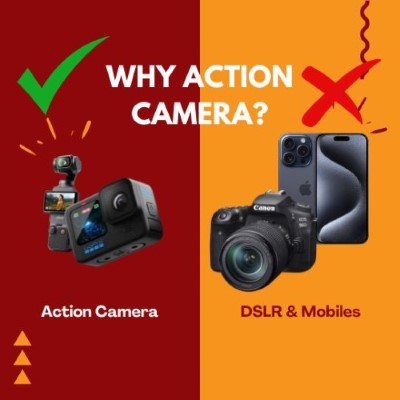In the age of smartphones with advanced cameras and the professional prowess of DSLRs, one might wonder why action cameras continue to be a preferred choice for many. Particularly for travelers, vloggers, and business professionals, action cameras offer unique advantages that make them indispensable tools. Here, we’ll delve into five compelling reasons to choose an action camera, compare them with the latest mobile cameras (like iPhones) and DSLRs, and explore specific use cases.
1. Superior Video Stability
Comparison:
- Action Cameras: Designed for adventure, action cameras like the GoPro Hero 12 and DJI Osmo Action 3 feature advanced stabilization technologies such as HyperSmooth and RockSteady. These technologies ensure smooth, shake-free footage even in the most turbulent conditions.
- iPhone and Mobile Cameras: While modern smartphones like the iPhone 14 Pro Max offer impressive stabilization features (like sensor-shift OIS), they often fall short in extremely dynamic environments.
- DSLR Cameras: High-end DSLRs with optical stabilization and gimbals can match or exceed action cameras in stability, but they are bulkier and require additional equipment.
Use Case:
For travelers and vloggers capturing high-action scenes—like skiing, mountain biking, or simply walking through a bustling market—action cameras provide unmatched stability.
2. Compactness and Grip
Comparison:
- Action Cameras: Compact and lightweight, action cameras are designed for easy handling. Their small size makes them perfect for mounting on helmets, bikes, or even handheld gimbals.
- iPhone and Mobile Cameras: While smartphones are portable, their larger size can make them less ideal for mounting in tight spaces or during high-motion activities.
- DSLR Cameras: DSLRs are significantly bulkier and heavier, making them less convenient for on-the-go shooting.
Use Case:
For business professionals on tours, the ease of carrying an action camera without the bulk of a DSLR can be a significant advantage. Quick to deploy, they are ideal for capturing spontaneous moments.
3. Battery Life and Device-Specific Benefits
Comparison:
- Action Cameras: Built for endurance, many action cameras boast long battery lives and swappable batteries. The GoPro Hero 12, for instance, offers up to 2 hours of continuous recording.
- iPhone and Mobile Cameras: Smartphone batteries are versatile but not specifically optimized for long video shoots. Intensive video recording can drain the battery quickly.
- DSLR Cameras: DSLRs can have excellent battery life, but they are not always designed for prolonged video recording sessions without overheating.
Use Case:
For long travel days or extended vlogging sessions, the ability to quickly swap batteries in an action camera ensures you never miss a moment.
4. Quick Deployment and Versatility
Comparison:
- Action Cameras: Ready at a moment’s notice, action cameras are perfect for capturing quick, unplanned events. Their rugged design allows for shooting in diverse conditions, from underwater adventures to capturing wildlife.
- iPhone and Mobile Cameras: Smartphones require a bit more setup, and their fragility can be a drawback in harsh environments.
- DSLR Cameras: While highly versatile in controlled settings, DSLRs require setup time and can be cumbersome in spontaneous shooting scenarios.
Use Case:
Whether it’s capturing a fleeting moment through a car window or documenting a surprise wildlife encounter, the rapid deployment of action cameras ensures you capture the action without delay.
5. Specialized Features for Extreme Conditions
Comparison:
- Action Cameras: Engineered for extreme conditions, these cameras are waterproof, shockproof, and dustproof. GoPro’s Hero series and DJI’s Osmo Action cameras are prime examples, offering superior performance in challenging environments.
- iPhone and Mobile Cameras: While some smartphones offer water resistance, they are not designed for prolonged underwater use or extreme sports.
- DSLR Cameras: High-end DSLRs can be weather-sealed but are not typically used for underwater or extreme sports without additional protective gear.
Use Case:
For underwater shooting, whether snorkeling or diving, an action camera is unparalleled. Similarly, for extreme sports like skydiving or rock climbing, their durability is a significant advantage.
Popular Action Cameras in the Market
- GoPro Hero 12: Known for its robust build, excellent stabilization, and versatile mounting options, the Hero 12 is a top choice for adventurers and vloggers alike.
- DJI Osmo Action 3: Featuring RockSteady stabilization, dual screens, and impressive 4K recording capabilities, it’s perfect for dynamic shooting conditions.
- Insta360 ONE R: A modular action camera offering 360-degree recording, making it a versatile tool for creative videography.
- Sony RX0 II: Combining the ruggedness of an action camera with the image quality of a premium compact, it’s ideal for those who prioritize image quality in extreme conditions.
Conclusion
While smartphones and DSLRs have their own strengths, action cameras fill a unique niche that makes them invaluable for specific use cases. For travelers, vloggers, and business professionals, the compactness, durability, superior stability, and specialized features of action cameras make them an essential tool for capturing high-quality, dynamic content. Whether you’re diving underwater, racing down a mountain, or simply documenting your journey on the go, an action camera ensures you never miss a moment of the action.
